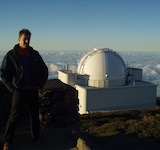GAM 2012 Blog
|
April 4 By Thijs Kouwenhoven |
Back to the GAM Blog |  |
| People have admired the heavens since the dawn of civilization. Initially, astronomy was mainly used for time keeping, particularly for religious and agricultural purposes. | ||
Many centuries later, the stars were also used for navigation the world’s seas. During the Renaissance, astronomy gradually developed into astrophysics, a mature natural science, and nowadays, astrophysics and space science have become the symbol for the scientific and technological advancement of mankind.
The vast majority of people from all over the world, as well as their governments, have a positive view on astronomy, as it attempts to address the biggest questions of science: where does the world come from, how will it end, and are we alone in the Universe? Astronomy is, at first sight, one of the cleanest sciences, free from too much interference from political, economic, and religious interest groups.
However, there have always been conflicts between astronomy and society. The most famous one involves the Catholic Church various astronomers such as Galileo Galilei and Nicolaus Copernicus. According to the church, the Earth was at the center of the Universe, while the astronomers at that time showed that observations indicated that the Sun was at the center of the Universe. This initiated a long and painful struggle between the church and science. Centuries later, in 2000, Pope John Paul II issued a formal apology for this, in particular for the trial of Galileo Galilei.
The construction of telescopes has also not been without controversy. A famous example is the opposition to the construction of astronomical observatories on the mountain Mauna Kea in Hawaii. The mountain is sacred for the indigenous population of the island, but it is also the ideal place to build a telescope.
Another conflict arises from the development of cities near astronomical observatories. Light pollution plays an increasingly important role in the site selection of telescopes. Developed countries have moved most of their telescopes to isolated locations in the world, but developing countries still have many of their observing facilities on their own territory. With the increasing development and growing wealth of the population, nearby cities grow in size, as well as in luminosity, especially due to street lighting and advertisements at night. Radio telescopes detect more television and mobile telephone signals than ever before. It is difficult to explain to the residents in that city that the astronomers are unhappy with their increased standard of living.
Finally, there is the discussion about the creation of the Universe. Did the Universe originate from a Big Bang 18 billion years ago, or was it created in seven days, several thousand years ago? Among the developed countries, this discussion is most prominent in the USA. Despite clear evidence that the Big Bang occurred, radioactive dating measurements, and dinosaur fossils, many people on the planet are still convinced of the creationist theory, and some interest groups even campaign for teaching both ideas as equivalent theories of the origin of the world.
It is clear that throughout the recent centuries, research in astronomy and astrophysics has brought great benefits to the world society. Although telescopes are larger than ever, and detectors have unprecedented sensitivity, it has become difficult to carry out state-of-the-art research in populated areas. Astronomers have moved their observatories to the most remote locations on the planet. Despite the occasional cultural and religious opposition to scientific progress, astronomy has enjoyed the support and enthusiasm of the majority of the world population, and has a great future ahead!
 Thijs Kouwenhoven at La Palma, Canary Islands (Spain) |
Bio: Thijs Kouwenhoven is a research faculty at the Kavli Institute for Astronomy and Astrophysics at Peking University in China. He did his undergraduate in astronomy at Leiden Observatory, and obtained his PhD from the University of Amsterdam. He subsequently worked for several years as a research associate at the University of Sheffield, after which he moved to China. |







